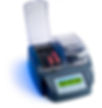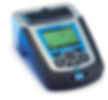Testing Equipment
- Rick Fuller
- May 1, 2017
- 6 min read
Updated: Jun 23, 2021
Testing Equipment for Water, Reverse Osmosis, and Wastewater
There are several "sets" of laboratory equipment that are critical for evaluating water (including reverse osmosis) and wastewater treatment systems. One set is for doing oxygen uptake rate (OUR) analysis in wastewater systems. Another set is for conducting adenosine triphosphate (ATP) evaluations in both water and wastewater treatment systems. A third set of equipment encompasses other items, such as handheld meters (colorimeter, turbidity, multimeter), pH and ORP probes, reagent test kits, and pipettes, that come in very handy in the field or in the lab. In fact, most of these items are absolutely essential to properly (and thoroughly) evaluate a treatment plant of any type. Many of these items can be used for testing either water or wastewater samples. The only exception would be the multimeter, described in more detail below, which should only be used for "clean" water applications such as reverse osmosis or boiler operations.

For many years now most of the equipment I order has been purchased from Hach (www.hach.com). The equipment can be expensive, but it is top-notch, accurate, reliable, rugged, and long-lasting. Hach is my first stop and first choice when looking for a laboratory item. The following equipment sections are detailed below:
1. Adenosine triphosphate (ATP)
2. Oxygen uptake rate (OUR)
3. Chemical oxygen demand (COD)
4. Reverse osmosis (RO)
5. Miscellaneous items
1. Adenosine Triphosphate (ATP) Test Equipment
This set of equipment is the most expensive I'll be listing here. It is also the most sophisticated, which does go a long way in explaining, if not justifying, the cost of these items. For those of you who work at a single plant, the important thing to keep in mind is that this is not testing you will be doing everyday. You will use ATP analysis to establish baseline or current operating conditions and then you will use it periodically to determine if conditions in the bioreactor are improving or worsening.
Because I travel from one site to another, often with long intervals before I return, I use ATP testing (along with OUR testing) at every plant I visit to develop a complete picture of current conditions. Depending on how the biological system looks, I may, or may not, use ATP testing to check for filamentous growth. That is why I show two wastewater test kits in the table below. The Advanced Wastewater Test Kit is much more expensive but is required for determining the quantity of filamentous microorganisms in a bioreactor. If I can forgo the filamentous testing, I use the more basic Wastewater Test Kit to reduce the cost of analysis.
(Clicking on any of the tables provided on this page will open up a PDF file listing all of the tables.)
No matter which test kit I decide to use once I'm at a site, I always run the following three ATP tests for every biological treatment system I am evaluating:
1. Cellular ATP (cATP)
2. Biomass Stress Index (BSI)
3. Active Biomass Ratio (ABR)
These, and other, ATP terms are defined in the post entitled: "Key ATP Terms" if you want more information.
Hach ATP Test Kit in a rugged case from LuminUltra
2. Oxygen Uptake Rate (OUR) Test Equipment
The cost for this set of equipment is reasonable and it can be used for multiple tasks. For example, you will need a handheld meter, Hach's single port HQ30D or the dual port HQ40D. Though you will be using this meter for your OUR testing you can also use the meter with many other probes such as ammonia, conductivity, pH, or oxidation reduction potential (ORP). Either of the meters are a pleasure to use, rugged for use in the field, and reliable!
Hach Luminescent BOD (LBOD) Probe

3. Chemical Oxygen Demand (COD) Test Equipment
Although most municipal wastewater plants use the 5-day biochemical oxygen demand (BOD) test to determine the organic concentration at various points in their treatment process, waiting five days for this key information is too long for many operators of industrial wastewater treatment systems. Operators of industrial systems often must contend with highly variable waste streams and they need to know the organic strength of these streams as soon as possible. This is where two-hour chemical oxygen demand (COD) testing is the preferred process control test for determining the organic concentration of a waste stream.
Hach's TNT series of tests, of which there are many, where the TNT means test-in-a-tube, makes field testing of waste streams simple and quick to accomplish. Though the particular focus here is on Hach's COD TNT test parameter, the TNT method is available for many other parameters such as alkalinity, ammonia nitrogen, and sulfate, to name just a few.
For COD TNT testing Hach offers four ranges as follows:
1) Ultra low range from 1 to 60 mg/L COD,
2) Low range from 3 to 150 mg/L,
3) High range from 20 to 1,500 mg/L, and
4) Ultra high range from 250 to 15,000 mg/L COD.

The range I tend to use most often is the high range, spanning COD concentrations from 20 to 1,500 mg/L. Using the TNT method from Hach simply requires that you add 2 mL of sample to the COD vial. You then place the vial in the COD reactor (shown below), "cooking" it for two hours at 150 degrees C.
Hach Digital Reactor

Please note in the image above the digital reactor shown is Hach's dual block unit. A single block unit is available but not recommended. The model I encourage you to get is the DRB200-02 which allows two different tests, at different temperatures and different heating periods, to be run simultaneously. The dual block unit costs just several hundred dollars more than the single block unit.
When the two hour heating period (for the COD test) is complete I use one of Hach's cooling racks (shown below) to let the vial cool down before measuring the concentration in a spectrophotometer.

Hach's benchtop spectrophotometer, ideally suited for a variety of testing, is the DR 3900 unit, shown below. With this spectrophotometer, the barcoded TNT vials will be automatically recognized and the concentration of the sample read automatically when you place the vial in the meter. This is a beautiful instrument but it is not the one I use in the field because of its size.

I use Hach's DR 1900 for testing in the field, shown in the two photographs below. This is an incredibly capable instrument that I ship ahead to project sites.
Hach DR 1900 Spectrophotometer


Information detailing all of the recommended equipment and pricing for running COD tests is provided in the table below. Please note that the purchase of the DR 1900 spectrophotometer and digital reactor heating unit will greatly expand your testing capabilities beyond chemical oxygen demand.
4. Reverse Osmosis (RO) Test Equipment
For general troubleshooting an RO system you are going to need two tools:
1. A handheld multimeter, and
2. A silt density index (SDI) kit.
A few reverse osmosis systems are well-run, with key operating data collected daily, with the data being input into an RO normalization program such as the DOW Filmtec FTNORM software. Many other RO systems are not monitored sufficiently which is why you and I end up being there. The best tool for evaluating RO feedwater, product water, and reject water is a multimeter, an image of which is provided below the table.
In addition to the multimeter you will likely need to check the silt density index of the feedwater. I really like the portable silt density index test unit with the optional booster pump available from Applied Membranes (www.appliedmembranes.com) which is shown in the image below. These units come in a rugged travel case that are great for field use and shipping to a site.
The value of the booster pump, an additional purchase, is that you don’t have to worry about finding a connection point to the RO feedwater line for the SDI tester itself. You can always find some means to at least access the feedwater source which allows you to fill a five-gallon pail and then use the booster pump to run your SDI test.
Hach MP-6 Multimeter

Applied Membranes SDI Tester
If you click on the image above, of the Applied Membranes SDI tester, you will open a PDF file that is a brochure for this excellent unit.
SDI Procedure
You can download several PDF files here that explain how to perform a silt density index test.
5. Miscellaneous Test Equipment
What I've listed here are some of the lab items I keep in my travel kits (the different size blue equipment cases from Hach shown below the table). The ORP and pH probes connect to the Hach HQ40D handheld meters I use for doing OUR testing. And the DR900 is a great little tool for testing important wastewater parameters such as orthophosphate and ammonia in and out of biological treatment systems. I use various size syringes for a lot of testing but nothing beats the ease and accuracy of the pipettes shown in the table.
Hach DR 900 Colorimeter
Hach Field Case with Rugged Probes

Hach Field Cases









